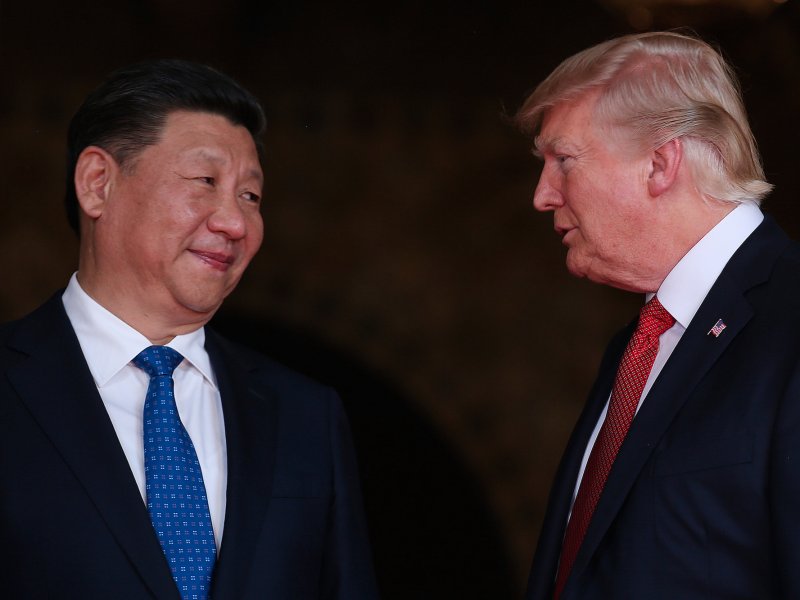 © REUTERS/Thomas Peter, President Trump takes part in a welcoming ceremony with China’s President Xi Jinping in Beijing.
© REUTERS/Thomas Peter, President Trump takes part in a welcoming ceremony with China’s President Xi Jinping in Beijing.- President Donald Trump is talking up the possibility of progress towards ending the trade war with China.
- But other parts of the administration are still going after China.
- Vice President Mike Pence took shots at China during a speech at the Asia-Pacific Economic Cooperation summit over the weekend.
- The Department of Commerce is also moving ahead with a rule that could limit the export of certain technologies to China.
- Trump and Chinese President Xi Jinping are scheduled to meet at the G20 summit at the end of November.
President Donald Trump may be talking up the prospects of a deal to ease trade tensions with China, but much of his administration is still acting like any agreement is a long way off.
Trump has discussed the possibility of a deal during his meeting with Chinese President Xi Jinping at the G20 summit later this month, and communications between Chinese and American officials seem to point to a possible détente.
But recent posture from Vice President Mike Pence and others in the administration have cast doubt that the drive for reconciliation will produce results.
Pence takes a hard line in Asia
The most public repudiation of China from the administration came during Pence’s speech at the close of the Asia-Pacific Economic Cooperation (APEC) summit in Papua New Guinea.
The vice president seemed to implicitly take shots at the Chinese economic model, reflecting continued differences between the two countries.
“We don’t drown our partners in a sea of debt. We don’t coerce or compromise your independence. The United States deals openly, fairly. We do not offer a constricting belt or a one-way road,” Pence said in an apparent reference to China’s Bet and Road initiative.
Pence also met with Xi during the APEC summit and told reporters afterward that China must agree to reforms for the US to agree to any deal lowering tariffs.
“We’ve put tariffs on $250 billion in Chinese goods and we could more than double that number, but we hope for better,” Pence said. “The United States though will not change course until China changes its ways
The Trump administration originally announced tariffs on Chinese products in March in response to China’s alleged theft of US intellectual property and uncompetitive practices for US companies operating in China. This lead to a furious, but ultimately fruitless, round of negotiations before the first set of tariffs were imposed in July.
In total, the US has applied tariffs to $250 billion worth of Chinese goods coming into the US, while the Chinese have hit $110 billion worth of US goods with duties.
The divisions between the US and China were again on display when the 21 APEC member countries were unable to agree on an official communique from the meeting. While the statement is largely ceremonial, it highlights the acrimonious relationship between the two largest APEC economies.
According to reports, China wanted to include language in the official remarks that rejected protectionism and unilateralism — echoing Beijing’s accusations about the US. On the other hand, the US wanted to include language that critiqued China’s trade practices.
Back home, the Trump administration’s fight with China is also taking another step foward
On Monday, the Department of Commerce began taking public comment on new rules that would give the administration the ability to restrict exports of certain critical technologies on the basis of national security — which could allow the US to stop exports of some technology to China.
Under the recently-passed Export Control Reform Act, the Trump administration can limit the export of “emerging and foundational technologies” to adversarial countries.
Under previous administrations, export controls were typically limited to technology with direct military capabilities. More general rules restricting exports that could theoretically have military applications would be a significant broadening of those restrictions.
Given this new power, the Trump administration wants to prevent exports related to 14 high-tech sectors, such as biotechnology, robotics, and artificial intelligence.
The new rule is also part of a broader campaign by various parts of the Trump administration to use non-tariff measures to put pressure on Chinese economic interests. For instance, the Department of Justice has increased the number of Chinese firms being charge with economic espionage and created a task force to combat illegal Chinese economic practices.
Fusion Media or anyone involved with Fusion Media will not accept any liability for loss or damage as a result of reliance on the information including data, quotes, charts and buy/sell signals contained within this website. Please be fully informed regarding the risks and costs associated with trading the financial markets, it is one of the riskiest investment forms possible.
Source: Investing.com



























